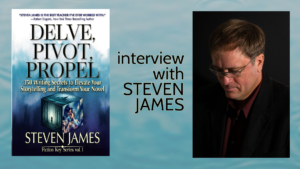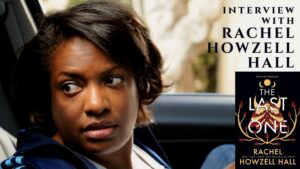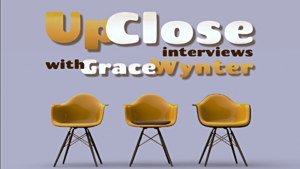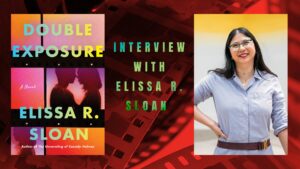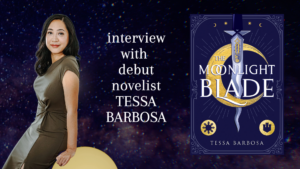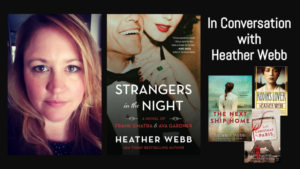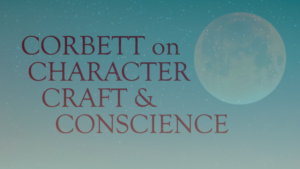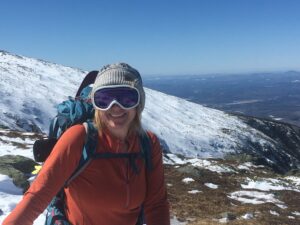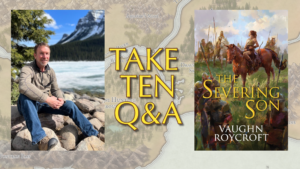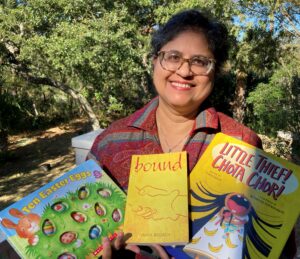Interviews
For today’s post I’m once again sharing the spotlight, this time with Steven James, whose writing guides are indispensable. His latest, Delve, Pivot, Propel, which arrived on December 3rd, is a crucial addition to his previous work, and it explores one particular issue I think is often neglected, inadequately addressed, or misunderstood: the pivot, aka the turning point or twist.
Steven is a critically acclaimed author of twenty novels and numerous nonfiction books that have sold more than 1 million copies. His books have won or been shortlisted for dozens of national and international awards. In addition, his stories and articles have appeared in more than eighty different publications, including the New York Times. He is also a popular keynote speaker and professional storyteller with a master’s degree in storytelling.
David: You’re one of the most relentlessly curious students of storytelling I’ve ever met. You’re always thinking about what makes stories great and how writers can accomplish that. Could you briefly outline what prompted you to take this new step in examining how stories work? What did you think was missing from other analyses of story? At one point you write, “[T]heexisting story theories were missing something essential to great stories, a moment in the narrative I’ve come to refer to as the pivot.” Was there anything else you noticed missing from existing analyses of stori
Steven: I’ve heard so many people espouse that stories have,“A beginning, a middle, and an end.” And every time I hear that, I think, “So does a bratwurst. How does the help me write my story?” Now, there’s nothing inherently wrong with this approach, but I don’t love it because it gives people the impression that a story is about a list of events—but it’s not. That’s a report. A story is about the collision of desires, not a progression of events.
Similarly, I had been trapped in the box of thinking of stories simply within a temporal framework—first act, second act, third act… inciting incident, rising action, dénouement—that sort of thing. It took me a long time to shift my thinking toward the narrative dynamics of the story and the essential elements to the story rather than continuing to parrot back the temporal aspects of story theory that we have all heard before. After all, you can have a story that works on the level of beginning, middle and end, but be entirely unsatisfying. How could that be? What were we missing? It took me a long time to realize what that was, and how to fix it in our stories.
The other aspects of story that I found were not taught enough were the pursuit and the payoff—that effective stories are not so much journeys as they are pursuits. And, you can have all the plot you want, but if there’s no emotional payoff in the story, you’re not going to impact your readers. So, I really had to step back from the paradigms I’d always heard (and taught) and take some new avenues toward a fresh perspective on story.
Stories always include tension, which is the result of desire meeting up with an obstacle. So, characters face an obstacle and, because of their unmet desire, they make purpose-infused choices that propel […]
Read MoreI’m guessing, given Tuesday’s election, most of us have been living in a world of, shall we say, heightened reality the past few days (if not weeks, or months). So, with no desire to diminish the importance or impact of that reality, allow me to offer a bit of a diversion, one I’ve had planned for some time: here’s an interview with Rachel Howzell Hall, known for her bestselling thrillers, about her turn to romantic fantasy with her latest book.
Rachel has been on a bit of a tear lately: her most recent previous novel, We Lie Here, was both a bestseller and nominated for a Los Angeles Times Book Prize. Before that she had three bestsellers in a row, What Fire Brings, What Never Happened, and These Toxic Things (also nominated for the Anthony Award, the Strand Critics Award, and the Los Angeles Times Book Award), with And Now She’s Gone garnering nominations for the Lefty, Barry, Shamus, and Anthony Awards.
With so much success in the thriller category, why jump ship and climb aboard an entirely different genre? I asked her that question (see below).
Meanwhile, The Last One, which comes out December 3, has garnered significant pre-publication praise:
The Last One can be pre-ordered now at Bookshop.Org, Amazon, B&N, Google Books, Kobo, Apple Books, or at your favorite local bookstore.
How did your agent (and/or editor/publisher) respond when you proposed a book so different from your past work?
Actually, it was my agent Jill Marsal who first reached out with the possibility of collaborating with publisher Liz Pelletier. I was thrilled at the opportunity—Liz is a genius. She was preparing to launch a new imprint from Entangled called Red Tower, filled with high-concept ideas she wanted to bring to life. I was honored to be one of the writers she thought would be a good fit for the project.
I get the feeling that this is a book you’ve been wanting to write for some time—have I got that right? If so, what kept you from getting to it sooner? How long did it take to imagine it, plot it out, and then get it down on the page?
I didn’t realize I wanted to write this book until I actually started. I was pretty intimidated by the idea of tackling not just one, but two new genres. I had never written a romance, and I had never written a fantasy. However, I soon discovered that I still had a lot to say—things I’d expressed before in mystery and crime—but now I had the opportunity to explore them in a world I could entirely create. A world without rules, until I made them.
I was offered the opportunity in July 2022 and began writing. I […]
Read MoreGreetings, WU Family! Today’s Up Close Q&A features fellow author, editor, and friend Margeaux Weston. I first got to know Margeaux when we were both a part of Sourcebooks’ BIPOC Editorial Training Program. Even back then, Margeaux displayed a keen eye for shaping stories, so I wasn’t surprised when she soon landed an agent, published a non-fiction title with Hachette, and became an acquisitions editor. Today Margeaux shares the wisdom she’s gained along her journey and provides a valuable behind-the-scenes look at the publishing industry.
GW: I’m a fan of origin stories, and though origin stories are usually used to describe superheroes, I love to use the term with published authors. What’s your writer-to-published-author origin story for your debut book?
MW: I love a good origin story as well! Interestingly enough, I started out writing pop culture articles for websites like Ebony Magazine and Paste. In 2020, on the heels of the George Floyd protests, publishers posted openings for for-hire writers. I applied and within a few months I was writing nonfiction books for young readers. It grew from there, and I soaked up all the information I could find about writing and getting an agent. I had a small list of agents I planned to query, including one I really wanted to work with. Two years later, that agent, Eric Smith, tweeted about wanting more nonfiction authors. I sent him my website and talked about my passion for writing for young readers. By that time, I had a few books under my belt and one that was pretty successful. We met and he became my agent soon after.
My journey is a tad bit different than what you’d expect in the querying process. Nonfiction is vastly different from fiction, and obtaining representation is often based on having a specialty or niche style or reputation. Once I had representation, I worked on polishing my proposal. In nonfiction writing, an agent pitches a proposal that includes market research, background information on the author and subject, and chapter samples. Publishers have to envision the “story” and have faith that the writer can deliver. Since becoming agented I’ve published an adaptation, Malcolm X and Muhammad Ali: The Fatal Friendship and have an upcoming nonfiction middle grade book with Bloomsbury.
GW: What do you think was the key(s) to getting that publisher to express interest in your manuscript—in other words, what made your manuscript stand out among hundreds of others?
MW: I’d say it’s a combination of timing and content. I worked in traditional publishing, so I know there are so many amazing manuscripts that come in, but they’re just not the right fit. It could be that the topic isn’t selling as well as it did a few years ago or it’s not what the publisher is looking for at the time. My upcoming nonfiction book with Bloomsbury is about neurodivergent people who shaped the world. That proposal sold at auction, and I believe that happened because the topic is timely and the content has a large appeal.
Read MoreElissa R. Sloan and I both grew up as half-Asians in Houston in the 1980s and 90s. We never went to the same school, but we had lots of friends in common, which eventually led to us connecting through social media and bonding over books, music, and other pop culture. Turns out, we had another big thing in common too: the dream of writing and publishing.
Now, Elissa’s third novel Double Exposure is coming out on Sep 10, 2024! I recently had the privilege of reading an early copy, and I’m excited to be in conversation with Elissa about her new book today.
Double Exposure is “a sweeping drama about two A-list stars as they cross each other’s paths over and over again through the years, in a story that examines the work we have to do in order to grow into the people we want to become.”
KH: Wow, I love that pitch. And it does a great job showing that Double Exposure goes deeper than the “gossip and gloss” of celebrity coverage on the internet or in magazines. There is a lot of social and political commentary embedded in the story of Maiko and Adrian’s lives. What compelled you to write about all this?
ERS: I started writing DOUBLE EXPOSURE in June 2022, right after the Dobbs decision. I knew I wanted a character to have an abortion in the first line, because I was angry, and when I’m feeling an intense emotion I tend to write. That first line has remained through all the revisions and rewrites. (For all three of my published novels, this pattern holds: the first line I wrote in the document ends up staying the first line throughout.)
I also knew I wanted an Asian-American lead, because my first two novels were predominantly about white women, and I was tired of that.
As for the story… I love second-chance romances. I had been working on a Persuasion retelling for a couple of years that was going nowhere, so I thought it would be interesting to write a whole new story about two people fated to be together, but the first time around, they couldn’t get over their individual obstacles to make the relationship work. The idea of two people growing, learning, becoming better versions of themselves and finding each other again really appealed to me.
And of course it had to be a Hollywood story, because I find the whole Hollywood culture so absorbing.
Read MoreToday I am delighted to present a conversation with our very own Tessa Barbosa, whose riveting debut novel THE MOONLIGHT BLADE came out yesterday. Tessa is a regular contributor here at Writer Unboxed, as well as a dear friend. We “met” maybe a decade ago through blogging, and bonded over our hyphenate identities and how that impacts our lives and our work. We’ve gone through many milestones in parallel over the years — from writing (and scrapping) manuscripts, to becoming mothers, to querying and being on submission… She is a gem of a person and a heck of a writer, and I’m over the moon that so many readers are about to discover her!
Let’s find out more about Tessa’s book, and her journey to this point.
KH: First, can you give a quick pitch of THE MOONLIGHT BLADE?
TB: Of course! It’s a story about a cursed girl who enters a deadly magical competition to save her condemned mother. She doesn’t know why her mother was arrested, but she soon discovers that she is the center of a conspiracy that spans past lives. If she doesn’t solve the mystery of who she is, and who she was, her curse could destroy the whole country – again.
KH: Phew, that’s a lot — in a good way! To me, THE MOONLIGHT BLADE felt like like a dash of Hunger Games (teens fighting to the death for a dubious distinction) + a spoonful of Laini Taylor (monsters, magic, past lives coming to bear) + a dozen heaping scoops of Tessa Barbosa (Filipino culture, family bonds, beautiful writing), which results in a story that’s incredibly fresh and vibrant, unlike anything I’ve read in a long long time.
What was the genesis of this story? How did THE MOONLIGHT BLADE start for you, and how did it come together?
TB: When I started writing it, I had a year old baby, and I’d taken a forced break from writing, because my pregnancy and newborn experience was so difficult. My daughter refused to sleep and cried constantly for 7 months straight. Every day I hoped it might get easier, but it didn’t for a long time. I was sleep deprived, and this story about complicated relationships between mothers and daughters, plus high stakes and a lot of pressure, somehow just poured out the moment I had a little free time again. It didn’t take long to draft the novel, but it took a substantial amount of time for me to revise it, because editing was a skill I didn’t have a lot of experience with yet.
KH: Oof, I’ve been there… With a tough baby, I mean. Never had a book pour out of me, sadly!
Your editing muscles must be incredible now, because Narra’s story is so powerful and layered. There is the mystery of her mother’s crime, the mystery of her connection to Teloh, the mystery of who is conspiring within the Fortress, and of course, the Sundo competition itself. How did you manage all these threads throughout the writing and editing processes?
TB: Staying VERY VERY organized. I have lists for everything, including a “story bible” which is an Excel spreadsheet with a description of every […]
Read MoreToday’s long-form interview of long-time contributor Heather Webb was conducted by our newest contributor here at Writer Unboxed: Emilie-Noelle Provost. Emilie-Noelle’s own debut novel, The River is Everywhere, released just this past week! Thank you, Emilie-Noelle and Heather!
We’re excited to share this interview today with Heather Webb, the bestselling author of nine historical novels. Her latest book, Strangers in the Night, a fictional retelling of Frank Sinatra and Ava Gardner’s famous love story, will be released on March 21.
“Heather Webb has set a new standard in historical fiction by writing a story that was so engaging that I forgot I was reading a book and not actually embodying the characters. Legendary stars Frank Sinatra and Ava Gardner come alive under her deft handling of their tumultuous and passionate relationship and will leave readers feeling like they’ve leapt from the page into living, breathing people that they know. A lifelong fan of the famous crooner, my own music listening will forever be quite impacted by Webb’s captivating book.”
— Camille di Maio, bestselling author of The Memory of Us
Heather is an adjunct instructor at Drexel University’s MFA in creative writing program, and for the last fifteen years has also worked as a freelance editor. Her next novel, Queens of London, the story of the city’s first all-female crime syndicate, will be released in 2024. Heather lives in New England with her family, a mischievous kitten, and one feisty rabbit. You can see what she’s up to on Facebook, Twitter, Instagram, Pinterest, and BookBub.
Emilie-Noelle Provost: Your newest novel, Strangers in the Night, will be released on March 21. The book is a fictional retelling of Frank Sinatra and Ava Gardner’s legendary romance. Can you talk about some of the reasons you were drawn to this story? What is it about old Hollywood that people find so captivating?
Heather Webb: I was approached by my publisher to write this book, actually. Of course, I was in as soon as I heard “Frank Sinatra.” I grew up listening to him at dinner parties and at my grandparents’ house, and I feel a bit of fond nostalgia every time one of his songs is playing in the background somewhere. He was a fascinating person with a very big life, so it was a lot fun digging into his story.
Ava Gardner, on the other hand, I knew nothing about, so I had a great time getting to know her, her films, and her life story.
I’m speaking for myself here in terms of the appeal of Hollywood, but just about everyone loves behind-the-scenes details about a famous person or event. It feels gossipy and secretive and a little fun.
The other aspect of Hollywood that’s appealing is filmmaking: acting, directing, producing, cinematography, music. It’s an enormous undertaking to put out a film, reliant upon many people. A lot of people find it really interesting. Plus, the weather there is beautiful; the people are beautiful, and the setting is beautiful (if you’re not stuck on the PCH or some other miserable interstate).
ENP: Why you chose to write Strangers in the Night in the first person?
HW: I […]
Read MoreEmilie-Noelle Provost atop Mount Adams in the White Mountains of New Hampshire
It is such a joy today to share this interview with Emilie-Noelle Provost . A new guest columnist on the blog, she’s also an established editor and writer. Her latest book, The River Is Everywhere, is the coming-of-age story of a Franco-American teenager and will be released on March 14, 2023. In her spare time she hikes and can often be found in the White Mountains of New Hampshire. When she’s not outside, you can find her on Facebook, Twitter, and Instagram.
Liz Michalski: I’m so excited for you and this novel. You are coming at it from a long stretch as a nonfiction writer and editor. How does that experience inform the way you approach writing fiction? What is your process like?
Emilie-Noelle Provost: I think my approach to writing both nonfiction and fiction comes from my fascination with history. I was history major in college. I have always been interested in the ways in which things that happened in the past continue to influence people’s lives decades, even centuries later. This is reflected in the subject matter of many of the nonfiction articles I’ve written. When I write fiction, it’s always somehow filtered through a historical lens. The characters in both my novels contend with circumstances that can be traced back to events that occurred long before they were born.
I’m not one of those people who can write from, or even create, an outline for a novel or story. I’ve tried and it always feels forced, which means the end product will, too. When I get an idea, I just start writing. It’s through the process of writing that a story evolves and takes shape.
LM: The River Is Everywhere is set in both the United States and Canada. Why was that important to you, and what kind of research did you do?
ENP: Ernest, the main character in The River Is Everywhere, is Franco-American. He, like me, is a descendent of the nearly one million immigrants who came to New England from Quebec during the 19th and early 20th centuries to work in factories. Because few people are aware of this history, I wanted to set the book partly in Canada to help make that connection in people’s minds. I also wanted the Canadian setting to serve as catalyst for Ernest to discover things about himself.
I did some basic research about the town in Canada where the book is partially set. It’s a real town, and many of the places mentioned in the book are based on actual places, but a lot of it is made up.
LM: Ernest Benoit, your main character, is a teenage boy. What drew you to that POV, and how did you work to make it sound authentic?
ENP: I wanted the main character to be a boy because in many ways it’s still taboo for boys (and men) to show a full range of emotions in life or in fiction. I thought creating a male main character who was fully […]
Read MoreIt’s a great pleasure to share our in-depth interview with regular WU contributor, assistant editor, stellar community member, and now published author Vaughn Roycroft, on the publication day of his debut novel, THE SEVERING SON! For as long as we’ve known Vaughn, he’s worked to craft this story world–a journey that has lasted nearly two decades and provided material for six novels. The first of those novels, out today as an e-book and in paperback, has already created waves in the fantasy world.
“With a fast pace and sweeping battle sequences, not to mention one of the best duels in fiction, The Severing Son will appeal to action-hungry readers of such authors as John Gwynne, George R.R. Martin, and Evan Winter.”
— Philip Chase, PhD aka YouTube’s Dr. Fantasy
“The author blends history with imagination to create a dramatic and engaging story. The Severing Son will appeal to lovers of historical fiction and epic fantasy enthusiasts alike.”
— Juliet Marillier, author of the Blackthorn & Grim and Warrior Bards series
Read on for an inspiring look back at what it took for Vaughn to get to this moment, and what’s next for him and his career.
Congratulations, Vaughn!
Which character did you imagine first, and what was it about him/her that made you sit down and write?
VR: I perfectly recall the day that I jotted down my first story idea in the world that became Dania and Pontea. I was working as a carpenter, rehabbing an older cottage. I was waiting for a concrete delivery, to pour a slab for a new porch, and I jotted it down in a pocket-sized notepad with a carpenter’s pencil. I’d already been reading about the fall of Rome and the role of the Goths in it.
I can’t find the notepad anymore, but the idea revolved around a Gothic scion, about to come of age, who wanders to the mountains at the border of his people’s realm, on the fringes of the empire. I immediately imagined ancient ramparts and the ruins of a tower and gate. I knew the young man was about to encounter someone who’d known his father. I knew he didn’t recall his father, who had left their homeland years prior, only to become entangled with the empire.
But the most important and memorable part of getting this vision—the thing that had me super excited—was that the scion was secretly being watched by a guardian. I immediately knew the guardian was a warrior woman who was about his age, and that she’d been assigned to him. I imagined her as being super competent and a bit dismayed by the bumbling nature of her subject (this is how my super competent wife plays into the original idea).
So the answer to the question is that I first imagined Thaedan and Ainsela, the son and niece respectively of Vahldan and Elan, the protagonists of my forthcoming debut, The Severing Son.
Thaedan’s and Ainsela’s unique relationship, its awkwardness and promise, was the thing that finally—after several years of “intending to write”—got my butt into the chair and words on the page.
I’m glad we’re able to talk about this early—the scope of this story, the multi-generational nature of the world you’ve created […]
Read MoreAs a novelist, all the book ideas I’ve ever contemplated hinge on an element of climate crisis, not by choice, but because these stories rise up as manifestations of my own climate anxiety. Stories about our global environmental emergency are simultaneously existential and minute.
They are urgent.
I would use the same words to describe The World as We Knew It: Dispatches from a Changing Climate (Catapult), a new anthology of personal essays about the impacts of climate change on the essayists’ lives edited by Amy Brady and Tajja Isen. Stories about drought in Arizona. Invasive species that change ecosystems. Nostalgia for absent fireflies. Hurricane Katrina.
This book is urgent.
But what makes this collection stand out among other anthologies addressing the climate crisis is the sense of urgency coupled with intimacy. The quality of the storytelling elevates the content in ways that inspire me as a fiction writer.
The all-star list of contributors includes some of the most compelling climate communicators of our time, both in fiction and nonfiction, including climate justice essayist Mary Annaïse Heglar, one of my favorite voices communicating about the climate crisis. In her voice, the complicated feels personal, terrifying, tender, and memorable. She contributed an essay called After the Storm about her family’s experience during and after Hurricane Katrina which will stay with me for a long time.
Novelist Omar El Akkad (American War and What Strange Paradise) contributed an essay about the devastating consequences of climate change and development in Qatar where he grew up, and his concern not only for our future but for our ability to preserve the past. Stories layered in stories. Urgent.
I read The World as We Knew It as a concerned citizen of this fragile planet and as a reader who appreciates powerful writing, but I also read the essays to study the architecture of compelling storytelling.
I read a lot of books on the craft of writing fiction. I subscribe to a long list of writerly newsletters and podcasts. Although The World as We Knew It is a collection of essays, not a book about writing, I’m shelving it with my books on the craft of writing because as I embark on writing my third novel, I anticipate returning to these essays many times as reminders of the power of urgent, intimate storytelling.
I reached out to the editors, Dr. Amy Brady, the Executive Director of Orion and the former Editor-in-Chief of the Chicago Review of Books, and Tajja Isen, the author of Some of My Best Friends: Essays on Lip Service and an editor for Catapult Magazine. They responded to my questions together, so their answers are in the ‘we’ form.
Julie Carrick Dalton: How did you choose the writers to include in your anthology?
Amy Brady and Tajja Isen: We collaborated on an initial dream list and were bowled over when most of the writers we contacted said yes! It was a mix of folks who had already published on climate, and those whose work we loved but hadn’t explicitly published in that space before. Their contributions, we felt, offered an exciting opportunity to expand what “climate writing” looks like, connecting the dots between the climate crisis and other narratives both global and personal.
JCD: Who is your intended audience?
AB […]
Photo by Marcos Luiz Photograph on Unsplash
In more ways than one, the Writer Unboxed community is the gift that keeps on giving. Today, I’m delighted to share one of those gifts with you. Many of you probably already know that our own Cathy Yardley is an award-winning author of romance, chick-lit, and urban fantasy and that she shares her skills with other writers through her Rock Your Plot system. But did you know that she’s worked with three different agencies over her career, feels that luck had a big part to play in launching that career, and is a self-described unrepentant nerd and geek? Cathy has sold over 1.2 million books and her answers to my Author Up Close questions give us a little insight into how she’s managed to do that. I’m sure wherever you are in your journey, you’ll find as much inspiration from her answers as I did.
GW: Thank you for agreeing to this Q&A. The first thing I like to ask authors is about their author origin story. It’s kind of like a superhero origin story but with a pen. What’s yours?
CY: I didn’t plan on being an author, although the signs were all there: I wrote stories from a young age, processed my troubles through journaling, attempted novels throughout college. I actually thought I’d be a publicist, and then maybe write a novel “after I retired.” I come from a family of accountants and engineers—writing wasn’t something we did! So until I won a writing contest for the RWA chapter I was a part of (and had only contributed to because we were short entries), it never occurred to me that I could actually pursue writing as anything other than a closeted hobby.
GW: Why do you write, what kinds of stories do you write, and who do you write these stories for?
CY: I write because I can’t help myself. I love stories, and my brain continually comes up with ideas and plot bunnies and details. I write romances and romantic comedy, for the most part, with some more serious threads wrapped in humor. I write them for readers who like love stories with found families, diversity, fun banter, food descriptions … and most of all, anything geeky. I am an unrepentant nerd and geek, and that tends to influence my writing heavily.
GW: Tell us a bit about your career. What was your “big break” in publishing? (You can include details about your query process, what worked and didn’t work for you, etc.)
CY: I have been very fortunate in my writing career. (Read: lucky as hell.) My first break was signing with Harlequin in 1999. It was an unagented submission – I can’t remember why they were accepting that at the time – but they had an author drop out of a scheduled miniseries, and my manuscript was just what they were looking for. I then queried my preferred agent, contract in hand. That was my first agent.
Read More
